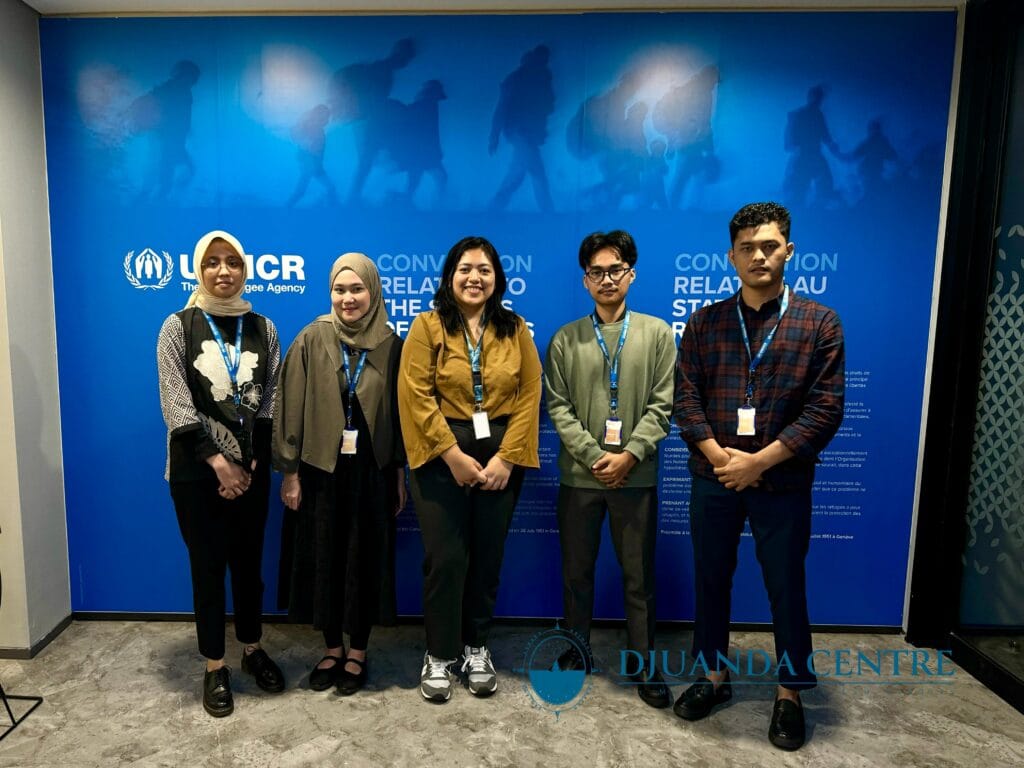Courtesy Visit to UNHCR Indonesia

On Wednesday, 19th of February 2025, Djuanda Centre paid a courtesy visit to United Nations High Commissioner for Refugees (UNHCR) Representative in Jakarta, Indonesia. We were met by Miss Dwita Aryani, Assistant Protection Officer. We talked about the ley lines that intersect upon Law of the Sea, International Air Law, International Refugee Law, as well as UNHCR’s duties and advocacy efforts for refugees in Indonesia.
We took off by drawing the clear distinction between refugees and asylum seekers. It is interesting to highlight that the process of determining the status of the former falls within the list of duties of UNHCR, considering Indonesia that serves as the transit country is yet to ratify the 1951 Refugee Convention. Additionally, dialogues surrounding refugees and asylum seekers are inseparable from the ever-raising issues on people smuggling and trafficking, which could only be addressed through transnational and inter-institutional cooperation.
In regards to the Law of the Sea, the discussion evolved around the Boat Arrivals phenomenon, the Rohingya refugees’ signature method of seeking asylum. Upon learning that a ship carrying Rohingya refugees is approaching the Indonesian maritime territory, UNHCR would then proceed to advocate the Indonesian government to assist them per the mandate of the Presidential Regulation No. 125 of 2016. As it turned out, however, in the procession of the Rohingya refugees’ arrival and the procedure to render the much desired assistance, there have been multiple interpretations on the concept of ‘Indonesian maritime territory’ adhered to by the stakeholders at play. Thus, trying to find the common ground to pinpoint which section of the waters that has been widely understood and accepted to have constituted as ‘Indonesian maritime territory’ in the practices surrounding the Rohingya refugees’ arrival flagged our interests. First, there are those who measure the Indonesian maritime territory within the territorial sea at least or likewise extended all the way to the Exclusive Economic Zones at most. Hence, assistance may be rendered within these UNCLOS-determined maritime zones. Second, there are those who draw the limitation not pursuant to the established maritime zones, instead by the circumstance surrounding the approaching ship. In this regard, assistance may only be given for ships in distress. Third, there are those who are in the opinion of slightly altered view from the latter. The third group believes that, per the UNCLOS, assistance are to be rendered not by authorities of the coastal states, but rather by other seaborne ship(s) should the refugees’ ship in distress appear in their visual range. It is intriguing to note the varieties of understandings on the long-established maritime concepts.
Lastly, we also talked about another and oftentimes tends to be overlooked or lesser known method of refugees’ arrival in Indonesia, which is the arrival by air. Refugees or asylum seekers’ entry by air into Indonesian soil adheres to the Immigration Law, as it is almost impossible for such entry to go unnoticed. In this particular method of entry, in addition to the typically rendered aid, UNCHR likewise always advocates so that the Indonesian immigration agency would refrain from sharing the entry data to the relevant embassy due to protection reasons.
We conclude our insightful discussions by initiating deeper collaboration between both institution in the near future, be it in the realm of academic research or others.
